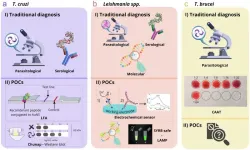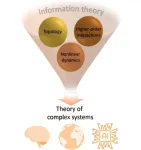(Press-News.org) Any patient suffering from new or worsening medical symptoms hopes for a relatively quick and accurate diagnosis.
However, for many people with episodic disabilities — periodic or intermittent conditions like migraines, lupus, Crohn’s disease and epilepsy, in which the presence and severity of symptoms fluctuate — a swift diagnosis is not guaranteed.
New research from Michigan State University focuses on diagnostic delays experienced by people with one such condition: epilepsy, a neurological disorder characterized by unpredictable seizures that affects over 3 million people in the United States and 50 million worldwide.
“Epilepsy has different symptoms that come and go, which makes it hard for doctors to identify using regular screening tools. People from low-income backgrounds and those whose seizures don’t show up on these tools often face the longest delays,” said Megh Marathe, an assistant professor in the MSU colleges of Communication Arts and Sciences and Human Medicine. “Without a diagnosis, these individuals may not get the treatment, support, benefits or understanding they need to make sense of their situation.”
Marathe’s research, published in Disability Studies Quarterly, draws upon 15 months of interviews with 25 people with epilepsy and 36 medical practitioners in a large research hospital in the Midwest. Of those with epilepsy, 52% experienced a delayed diagnosis, waiting several months and up to 5 years for official confirmation, while 48% experienced a quick diagnosis, within days of their first seizure.
Marathe analyzed these two forms of diagnosis using a narrative structure:
Quick diagnoses resembled progress narratives, with each step advancing participants to a formal diagnosis of epilepsy. These participants typically had clinicians as close social relations, the ability to access specialty care, and others had witnessed their seizures.
Delayed diagnoses resembled cyclical narratives, in which participants were stuck in cycles of unresolved symptoms and unhelpful medical encounters until chance and/or advocacy led to diagnoses. These participants often sought care in generalist settings, had normal routine testing results, and experienced long-lasting medical confusion due to nontypical symptoms.
“The pace of diagnosis may depend, in part, on the seizing person’s life circumstances, sociocultural biases associated with their race, sites at which they can access care, and routine testing results,” Marathe said.
EEG tests, which help visualize the brain’s activity in continuous waveforms, are the primary form of screening for epilepsy. And while they can help to confirm a diagnosis, the timing of the test — and its duration — can make all the difference.
“Abnormal EEGs indicate seizures and epilepsy, but normal EEGs don’t rule them out,” Marathe said. “People with epilepsy can have normal brain activity outside seizures and might not have a seizure during the 20-40 minutes typical of the routine EEG test. In addition, EEGs may not detect seizures deep in the brain due to the skull’s shielding and smoothing effect.”
People experiencing seizures for the first time typically visit generalist health care settings, such as primary and emergency care, because specialty care often presents barriers like longer waits for appointments, higher costs, and distance and transportation challenges. Unfortunately, generalist medical practitioners have much less training and exposure to epilepsy than specialists and can only order short, routine EEGs that often fail to detect signs of epilepsy in 41%-68% of people known to have the condition.
“Generalist medical practitioners receive limited training and exposure to epilepsy. Most are trained to recognize generalized and convulsive seizures: obvious signs of the condition. However, participants reported that generalist practitioners did not recognize nontypical seizures and indirect signs of epilepsy,” Marathe said.
Of people with epilepsy, 36%-65% have nontypical seizures with symptoms that aren’t always visible or commonly associated with epilepsy and can include abrupt and involuntary changes in emotion, cognition and sensation; autonomic function (like nausea or respiratory sensations); and bodily movement (e.g., tensing, slackening or suspension of activity in part of or all the body).
Despite the failure rate of routine EEGs, participants reported that when their EEG results were normal, generalist practitioners ruled out epilepsy and sent them home without a diagnosis — or misdiagnosed them with another condition, contributing to the cyclical narrative.
“Participants with delayed diagnoses remained stuck in cycles of unresolved symptoms, normal routine EEGs and frustrating medical encounters,” Marathe said. “In each case, participants obtained an epilepsy diagnosis after months of worsening symptoms, with self-advocacy and chance leading them to physicians who attended to indirect and implied signifiers of epilepsy. Participants from low-income backgrounds were especially acceptable to this sustained denial of recognition.”
For people whose seizures occur in the presence of others or during medical testing and are able to access specialty care, diagnosis is often straightforward. Delays typically occur when clinical practitioners fail to recognize seizures due to norms in medical education and practice or as a result of the lack of specialized knowledge in primary and emergency care.
“In episodic disabilities, the fleeting and unpredictable quality of symptoms complicates diagnosis, and the pace and duration of diagnostic journeys varies for differently situated people,” Marathe said.
Episodic disabilities present a problem to how medical signs and symptoms are currently analyzed, resulting in a complex signifying mechanism, argued Marathe. Practitioners should be trained not only to recognize visible signs, but to analyze the underlying and invisible basis for conditions like epilepsy and take demographic and socioeconomic factors into account.
“When diagnosing epilepsy, practitioners should attend to the confluence of class, race, gender, age, access to health care and social support that can all have impacts on how long it takes for a person to obtain a diagnosis,” Marathe said. “Physicians must keep the limited accuracy of screening tests in mind, and look beyond test results and pay attention to relevant nuances of patient history”
###
Michigan State University has been advancing the common good with uncommon will for 170 years. One of the world’s leading public research universities, MSU pushes the boundaries of discovery to make a better, safer, healthier world for all while providing life-changing opportunities to a diverse and inclusive academic community through more than 400 programs of study in 17 degree-granting colleges.
For MSU news on the web, go to MSUToday or https://x.com/MSUNews
END
MSU study: Socioeconomic factors, unpredictability complicate diagnosis of episodic disabilities, like epilepsy
2025-02-19
ELSE PRESS RELEASES FROM THIS DATE:
Revolutionizing tropical disease treatment: The future of conjugating nanomaterials with drugs
2025-02-19
Introduction
Neglected Tropical Diseases (NTDs) remain a significant health burden in tropical and subtropical regions, with limited treatment options and diagnostic capabilities. These diseases are often neglected in research and policy, yet they contribute to high mortality and morbidity worldwide. Nanotechnology, particularly the conjugation of nanomaterials with drugs, presents an innovative approach to improving both the diagnosis and treatment of these diseases. Nanomaterials have unique properties that allow for enhanced drug delivery, ...
Improving quality of life and end-of-life care: Standardizing goals of care notes in EHRs
2025-02-19
INDIANAPOLIS – It is important that a healthcare team is aware of and understands a patient’s goals of care, both medical and personal. But that information, if documented, typically is not placed in a standardized location and is difficult to find within a patient’s voluminous electronic health record (EHR).
A new study by researchers from Regenstrief Institute, the Indiana University School of Medicine and Indiana University Health presents the standardized goals of care note they developed, deployed and evaluated as a quality improvement initiative at ...
Taking vitamin E during pregnancy may decrease peanut allergy in children
2025-02-19
New research found that supplementing maternal diet with α-tocopherol, a form of vitamin E, can reduce the development of food allergy and anaphylaxis in newborn mice.
The prevalence of food allergy in children increased 50% from 2007 to 2021 in the United States (US), with the incidence of peanut allergy tripling in that time. This new study, published in The Journal of Immunology, shows the potential for α-tocopherol in prenatal vitamins during pregnancy and lactation to address this alarming increase and reduce development of food allergy early in life.
The study found that ...
AI in retail: how to spark creativity and improve job satisfaction
2025-02-19
Artificial intelligence (AI) is reshaping workplaces by streamlining routine tasks and boosting efficiency, particularly in retail, where innovation is essential for maintaining a competitive edge. Beyond automation, AI supports employee creativity by offering valuable insights and allowing them to focus on innovative tasks. However, research is limited on how AI service quality impacts employees in retail industries, making this an important area to explore.
Researchers from Florida Atlantic University and Hanyang University in Seoul, South Korea, examined how perceived AI service quality influences retail employees’ ...
1 in 5 older adults get infections after heart surgery, and women have a 60% higher risk
2025-02-19
One in five older adults gets an infection up to six months after heart surgery — with women far more likely to develop one, according to studies led by Michigan Medicine.
The two studies examined thousands of cases involving Medicare beneficiaries who underwent coronary artery bypass grafting, also known as CABG or heart bypass, or aortic valve replacement.
Women had 60% greater odds of developing postoperative infections, the three most common being urinary tract, pneumonia and sepsis.
Black patients also had higher rates of overall infection (28%) ...
New funding to support food security, economic resiliency
2025-02-19
DALLAS, Feb. 19, 2025 — The conditions in which we are born, live, learn, work, play and age — the social drivers of health — are better predictors of health and life expectancy than our genetic code. In communities nationwide, people living in locations just a handful of miles apart can have a dramatic difference in life expectancy.
To help level the playing field, the Grubhub Community Fund awarded the American Heart Association® Social Impact Funds a $2 million grant to support food security, technology innovation and economic resiliency in New York City and Chicago.
“We are grateful ...
All generic drugs are not equal, study finds
2025-02-19
COLUMBUS, Ohio – Generic drugs manufactured in India are linked to significantly more “severe adverse events” for patients who use them than equivalent drugs produced in the United States, a new study finds.
These adverse events included hospitalization, disability, and in a few cases, death. Researchers found that mature generic drugs, those that had been on the market for a relatively long time, were responsible for the finding.
The results show that all generic drugs are not equal, even though patients are often told that they are, said John Gray, co-author of the study and professor of operations at The Ohio State University’s ...
Enhancing shareholder accountability: Lessons from Japan’s corporate governance reforms
2025-02-19
Shareholders play a crucial role in corporate governance by voting on key decisions in the companies they invest in. To enhance transparency, regulatory bodies worldwide—such as government agencies and stock exchanges—are increasingly implementing guidelines to hold institutional investors accountable for their voting behavior and ensure they fulfill their fiduciary duties.
A study published in the journal Corporate Governance: An International Review on 22 January 2025 demonstrates that these regulations, even if non-binding, can encourage institutional investors to play a more active role and improve corporate governance. The study, conducted ...
A new treatment for post-amputation pain?
2025-02-19
Procedure is simple and could be adopted by most U.S. hospitals
Roughly 2 million people in the U.S. live with limb loss; number is expected to rise
Senior author, a retired U.S. Army colonel, traveled to Ukraine to set up the study
CHICAGO --- A reliable method to treat post-amputation pain remains elusive, but a new Northwestern Medicine study conducted in collaboration with Ukrainian physicians suggests that hydrodissection — a simple procedure that injects fluid around nerves — may reduce residual limb pain and opioid dependence.
The ...
Groundbreaking study reveals how topology drives complexity in brain, climate, and AI
2025-02-19
(Embargo: 19 Feb, 10am GMT) A groundbreaking study led by Professor Ginestra Bianconi from Queen Mary University of London, in collaboration with international researchers, has unveiled a transformative framework for understanding complex systems. Published in Nature Physics, this pioneering study establishes the new field of higher-order topological dynamics, revealing how the hidden geometry of networks shapes everything from brain activity to artificial intelligence.
“Complex systems like the brain, climate, and next-generation artificial intelligence rely on interactions that extend beyond simple pairwise relationships. Our study reveals ...



